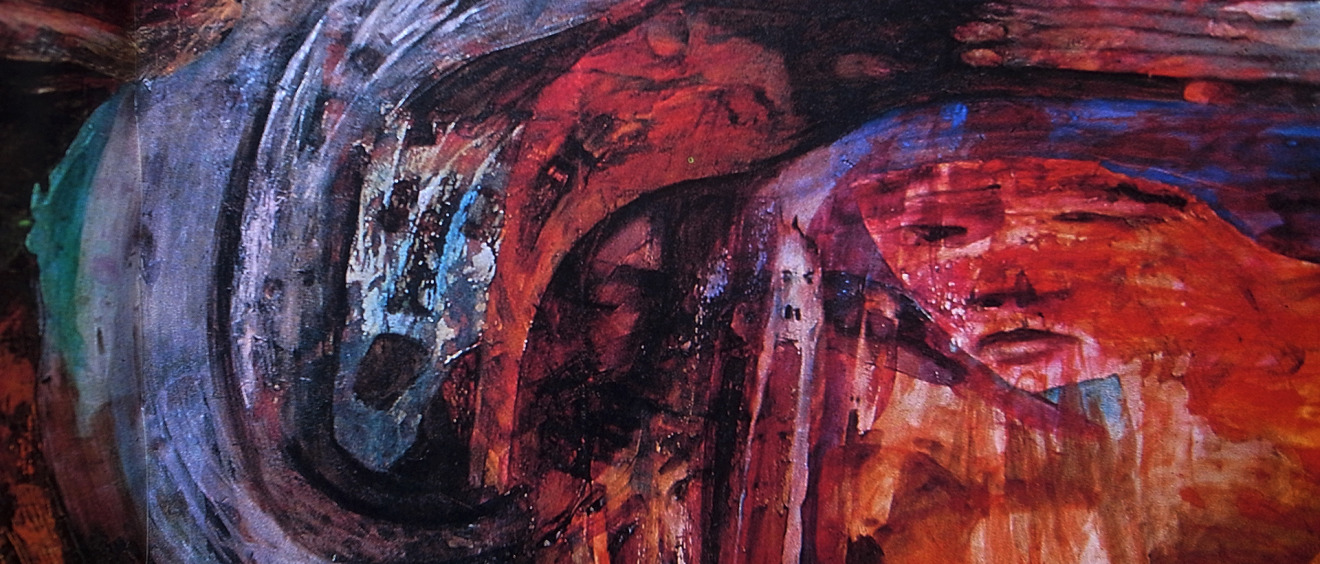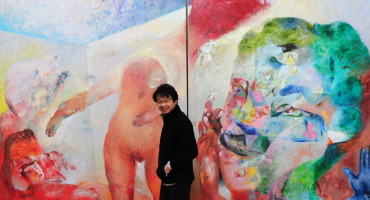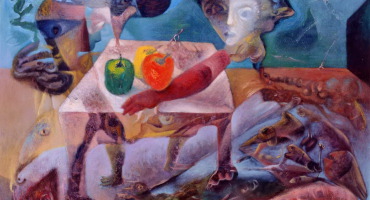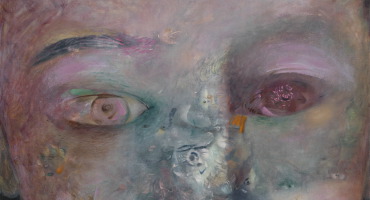
A Clear Path from the Mists
Alixe Fu was a student at Chinese Cultural University when I was teaching there in 1984. Although this was a long time ago, I still have a deep impression of him. His thick glasses and furrowed brow made him look as if he had many worries, and when asked a question, he was barely able to speak a few words. It seemed he was always wrapped in an atmosphere of sadness and abandonment as things never went as planned. When I saw him again it was the winter of 2007, and although he was already middle aged, had a painting career and was married with children, I still felt he was a gifted person trapped in his own lonely world.
Alixe Fu recently invited me to have a look at his current work. He has been painting about flesh, sex and the absurdity and contradictions in life. The human f igure is the main theme in his paintings, and appear in various forms: both male and female, some of dubious gender, some paintings seem to contain one figure, others one figure with two bodies, some seem to have many faces or eyes, or the same figure has many limbs with feet that are sprouting many toes. Alixe Fu explains, “The senses of these figures are especially acute due to their connection to desire. Their desire also creates worried and anxious feelings which in turn create the potential for action.” He not only has many stories yet to tell, but also has many faces yet to paint, and even more, he continues to strive to capture different spirits. This story teller doesn’t separate himself from the world, wielding a mighty pen to pass judgment, but on the contrary, he paints continuously and inconclusively without making any definite lines or using any absolute color. It is no wonder that his sharp wit and sensitive mind carries forth his experiences so successfully. The gifted person has yet to transform into a worldly one, and so still walks alone.
I haven’t seen many of the artist’s early works in person, but they can be seen in many catalogs and his creative output is abundant. When Alixe Fu was young, he was influenced by many different schools of modern figurative painting, and elements of Cubism, Fauvism, Futurism, Expressionism and Surrealism all appear in his paintings. The narrative qualities in his paintings aren’t pronounced, nor do they rely on literary expression, but are more appropriately described as ideographs. Italian abstract painter Francisco Clemente once said that their painting process was like inventing ideograms.”1 Chinese characters are ideograms that have evolved based on the six classifications of pictogram, ideogram, compound indicative, phono-semantic compound, borrowed character, and derived character. Alixe Fu has provided us with a good deal of paintings that are like ideograms. Although these images themselves don’t contain any indication of time, objects or disputes, when put together they can describe a vast world and countless feelings. Alixe Fu is a competent painter of these ideograms, and not at all worried about repenting or setting examples, nor is he seeking to easily crush humanity (hatred, resentment, heretical or wanton descriptions are rarely seen in his works). His work doesn’t take a stand against society or serve as a tool of dissension (there are few political, violent or sexual topics in his work). Alixe Fu is essentially promoting a group of his figurative paintings and adding more to an already dense forest of pictorial works. This kind of artwork and the historical repression of figure painting in China are related. In the article Finding the Body’s Home-Prototypes of Alixe Fu’s Plant and Animal Figures, Fu’s wife stated, “The humanistic qualities of Chinese ink painting are put into play with a tendency towards natural materialism, and actually put the topic of humanity in parentheses to be discussed later. This is a critical factor in the decline of traditional ink painting. Traditional aesthetics neglect the power of dynamism and irrationality within the human instinct (evil and the devil), that is to say, the desiring body was kept apart from the object to which it was in opposition.”2
Alixe Fu deconstructs the features and four limbs and situates them in an indistinct space. We of ten see eyes, noses, fingertips and nipples randomly placed around the indistinct interiors and exteriors of spaces or bodies and he paints everything in different scales. Time seems to implode as subject and object are confused. Sometimes he composes clearly defined volumes, and other times bodies appear as pi les of difficult to differentiate decapitated corpses. Sometimes, like a medium he calls forth spirits and then leaves spirits floating in midair freely ascending and descending (On Mount Blanc, 1990). Sometimes, gazing at the bodies he has arranged in rows like a mortician, he mourns their death (Window, 1989).
The painter Julian Schnabel once said, “Everything in a painting has a soul, otherwise I am just making things. Everything I paint is reality. A pile of fantasies compose
reality, life is produced from death, a bundle of mistakes creates a bouquet of flowers.”3 Schnabel believes an artist provides society with a new angle on reality, and Alixe Fu’s paintings also provide a fresh point of view. All of his paintings are of figures, but ultimately his paintings are about life energy and souls, and this is why he usually only emphasizes the eyes, hearts, feet and hands of his figures, and also why he doesn’t depict their genitals. These spirits present us with a reality which is just like the complex dialectical relationship between the Buddha and devil, infatuation and enlightenment or reality and fiction, and give us the feeling of broken dreams, but also make reality progressively more clear. After continually reading his work, the confusion in his paintings becomes increasingly clearer. This also perfectly echoes the time line of developments in Alixe Fu’s work; from the confusion in his early work to the relatively stable and integrated paintings of today. Throughout this course, the body is continually deconstructed and reconstructed, and lust is extinguished and rekindled. However, the reality of life is established on this framework of continual dialectic.
I am reminded of what David Der-wei Wang once wrote in a critical essay about Eileen Chang, “Eileen Chang has al l along used small scenarios for large ambit ions, like gossip substituted for a loud cry, repetition for creativity and involution for revolution, which results in a radically different branch of narration. I use involution to mean doubling back, circling around or self-consumption to reflect beauty. This is the exact opposite of the upheaval and replacement that revolution manifests.”4 I am left with the same feeling after reading Alixe Fu’s paintings. While most contemporary artists are busy developing new media and attempting new ways of reconfiguration to bear witness to the times, Alixe Fu has been consistently focused on repetition, involution and derivation in his world of painting. From the early work until now, Alixe Fu has been a painter working in the spirit of Eileen Chang. He presents dual or multiple points of view based on memories of what he has seen, resembling loss in ways both cordial and strange, both gloomy and radiant. With jumbled contrasts, countless resplendent visions are derived from endless cycles, replete with the shadows of ghosts which are difficult to conceal.”5
Alixe Fu views himself as full of complexity and distress which he attributes to his childhood (he grew up in an poor household without a father). In order to make up for this lack, he uses continuous repetition and derivation in the form of revealing daydreams, fantasies, relived experiences, memories and dreams. Although it seems chaotic, this method has the same spirit as cures that have proven effective in the past. In Alixe Fu’s paintings, ideograms repeatedly appear, piecing together what could almost be read as sentences, and every exhibition presents a chapter, which provides something that can’t be termed a cure, yet is an endeavor or rite with curative effects.
In the past several years Alixe Fu has devoted himself to sculpture, which has lent a sculptural quality to his paintings. These sculptures are derived from his oil paintings and sketches and have pushed his paintings in a more integrated direction. A great amount of bright colors can be seen in the work and although the figures are expressive and full of significance, they also have definite weight and direction; anxious feelings, even desire, seem to have turned in and become active life force. Because of his increasing skill in using ideograms, bodily desire is becoming clearer as the work continues to evolve. The link between the artist and his subjects is also becoming increasing evident, and although indistinct images continue to appear in his paintings, they don’t seem to be flickering shadows of ghosts, but rather give us a feeling of connection, like family or a textual genealogy and strengthen the momentum of the figure.
Alixe Fu doesn’t employ popular expressive forms, shocking avant-garde techniques or wield social themes to dominate the audience’s field of vision, yet as a disciple of Eileen Chang, he has gradually become known for his visual aesthetic of repetition, involution and derivation. The recently modernized art world of Taiwan still lacks depth and power, but Alixe Fu makes up for this deficiency with involution and derivation, paving a solid path for newcomers anxious to step out of modernity and break new ground in the postmodern. While raising ghosts and piling the dead, Alixe Fu has become an excellent storyteller.
Endnotes:
1 Stiles and Selz, Theories and Documents of Contemporary Art, University of California Press, Berkeley, 1996, p261
2 Tsai Ling-yen, Finding the Body’s Home-Prototypes of Alixe Fu’s Plant and Animal Figures, Miyabi Gallery, Nagoya, Japan, 2002
3 Tsai, p266
4 Wang, David Der-wei, Post-loyalist Writing, Rye Field Publications 117,p167
5 Wang, p167



